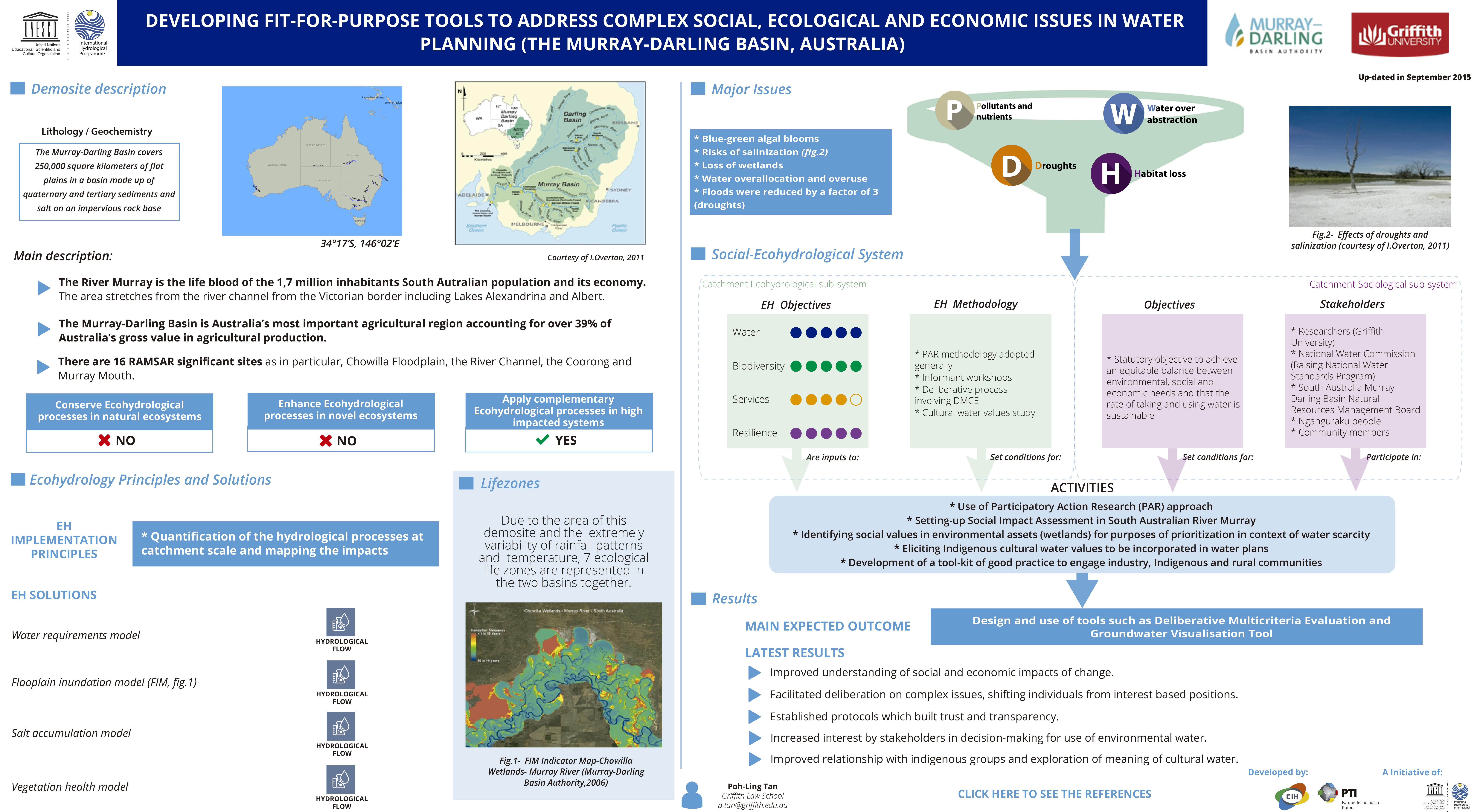DEVELOPING FIT-FOR-PURPOSE TOOLS TO ADDRESS COMPLEX SOCIAL, ECOLOGICAL AND ECONOMIC ISSUES IN WATER PLANNING (THE MURRAY-DARLING BASIN, AUSTRALIA)


Description
Location


Sketch

Information about lithology/geochemistry:
The Murray-Darling Basin covers 250,000 square kilometers of flat plains in a basin made up of quaternary and tertiary sediments and salt on an impervious rock base
Main Description
- The River Murray is the life blood of the 1,7 million inhabitants South Autralian population and its economy. The area stretches from the river channel from the Victorian border including Lakes Alexandrina and Albert.
- The Murray-Darling Basin is Australia’s most important agricultural region accounting for over 39% of Australia’s gross value in agricultural production.
- There are 16 RAMSAR significant sites as in particular, Chowilla Floodplain, the River Channel, the Coorong and Murray Mouth.
Enhance ecohydrological processes in novel ecosystem
NO
Apply complementary Ecohydrological processes in high impacted system
YES
This table presents the different categories of ecosystem services that ecosystem can provide, divided in:
Provisioning Services are ecosystem services that describe the material or energy outputs from ecosystems. They include food, water and other resources.

Fresh water: Ecosystems play a vital role in the global hydrological cycle, as they regulate the flow and purification of water. Vegetation and forests influence the quantity of water available locally.
Regulating Services are the services that ecosystems provide by acting as regulators eg. regulating the quality of air and soil or by providing flood and disease control.

Moderation of extreme events: Extreme weather events or natural hazards include floods, storms, tsunamis, avalanches and landslides. Ecosystems and living organisms create buffers against natural disasters, thereby preventing possible damage. For example, wetlands can soak up flood water whilst trees can stabilize slopes. Coral reefs and mangroves help protect coastlines from storm damage.

Erosion prevention and maintenance of soil fertility: Soil erosion is a key factor in the process of land degradation and desertification. Vegetation cover provides a vital regulating service by preventing soil erosion. Soil fertility is essential for plant growth and agriculture and well functioning ecosystems supply the soil with nutrients required to support plant growth.
Ecosystem services "that are necessary for the production of all other ecosystem services". These include services such as nutrient recycling, primary production and soil formation.

Habitats for species: Habitats provide everything that an individual plant or animal needs to survive: food; water; and shelter. Each ecosystem provides different habitats that can be essential for a species’ lifecycle. Migratory species including birds, fish, mammals and insects all depend upon different ecosystems during their movements.
Cultural Services corresponds nonmaterial benefits people obtain from ecosystems through spiritual enrichment, cognitive development, reflection, recreation, and aesthetic experiences.

Recreation and mental and physical health: Walking and playing sports in green space is not only a good form of physical exercise but also lets people relax. The role that green space plays in maintaining mental and physical health is increasingly being recognized, despite difficulties of measurement.

Tourism: Ecosystems and biodiversity play an important role for many kinds of tourism which in turn provides considerable economic benefits and is a vital source of income for many countries. In 2008 global earnings from tourism summed up to US$ 944 billion. Cultural and eco-tourism can also educate people about the importance of biological diversity.

Aesthetic appreciation and inspiration for culture, art and design: Language, knowledge and the natural environment have been intimately related throughout human history. Biodiversity, ecosystems and natural landscapes have been the source of inspiration for much of our art, culture and increasingly for science.

Spiritual experience and sense of place: In many parts of the world natural features such as specific forests, caves or mountains are considered sacred or have a religious meaning. Nature is a common element of all major religions and traditional knowledge, and associated custos are important for creating a sense of belonging.
EH Principles
Quantification of the hydrological processes at catchment scale and mapping the impacts
ECOHYDROLOGY ENGINEERING SOLUTIONS
Salt accumulation model
 Hydrological Flow
Hydrological Flow
Water requirements model.
 Hydrological Flow
Hydrological Flow
Flooplain inundation model (FIM, fig.1)
 Hydrological Flow
Hydrological Flow
Vegetation health model
 Hydrological Flow
Hydrological Flow
Major Issues
- Blue-green algal blooms.
- Risks of salinization (fig.2).
- Loss of wetlands.
- Water overallocation and overuse.
- Floods were reduced by a factor of 3 (droughts).






Expected Outcomes
Design and use of tools such as Deliberative Multicriteria Evaluation and Groundwater Visualisation Tool.
Latest Results
- Improved understanding of social and economic impacts of change.
- Facilitated deliberation on complex issues, shifting individuals from interest based positions.
- Established protocols which built trust and transparency.
- Increased interest by stakeholders in decision-making for use of environmental water
- Improved relationship with indigenous groups and exploration of meaning of cultural water.
Contacts
Poh-Ling Tan
- p.tan@griffith.edu.au
- https://www.griffith.edu.au
- Griffith Law School
- https://www.griffith.edu.au

Social ecohydrological system
EH Objectives
EH Methodology
Catchment Ecohydrological sub-system
Objectives
Stakeholders
Catchment Sociological sub-system
Activities